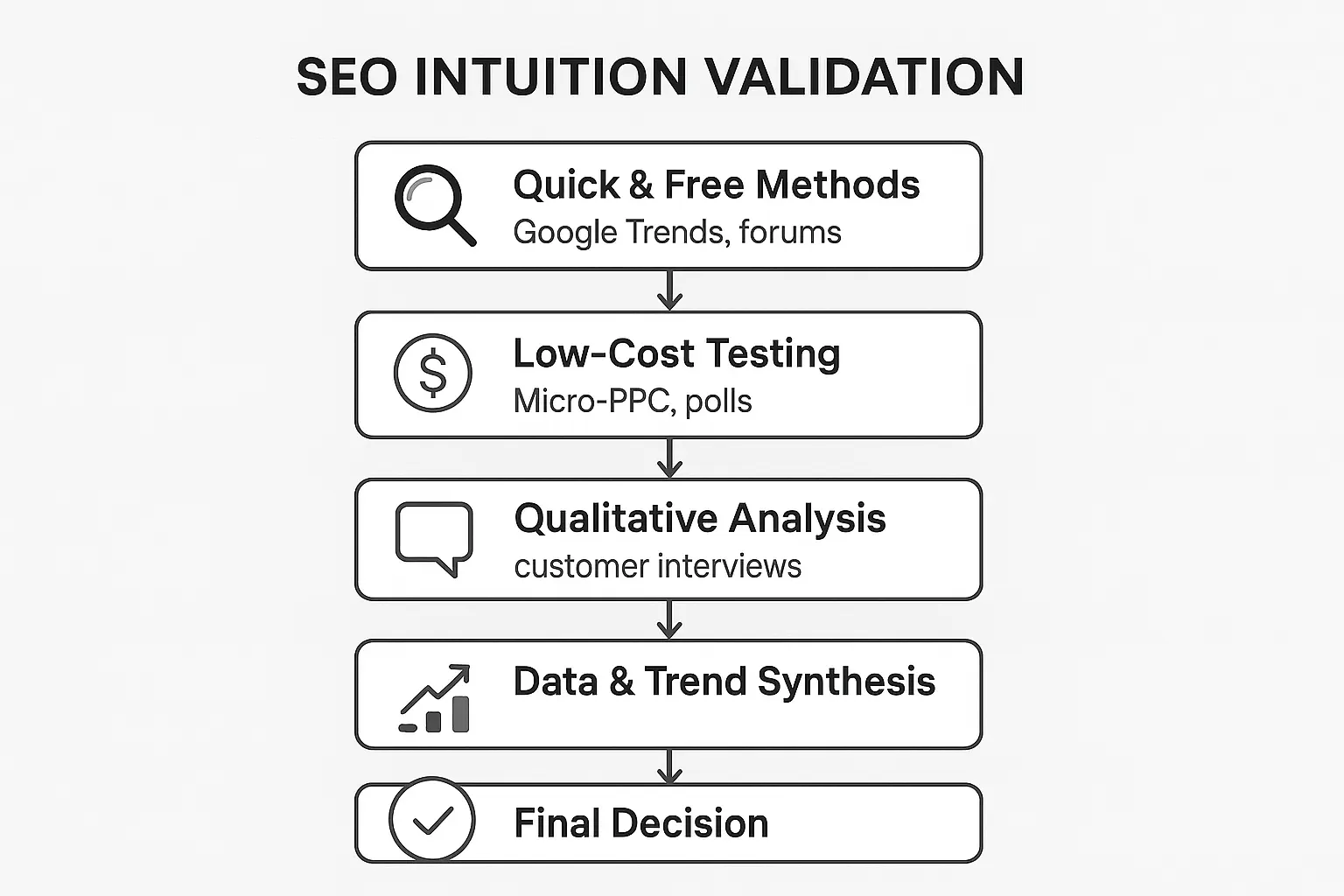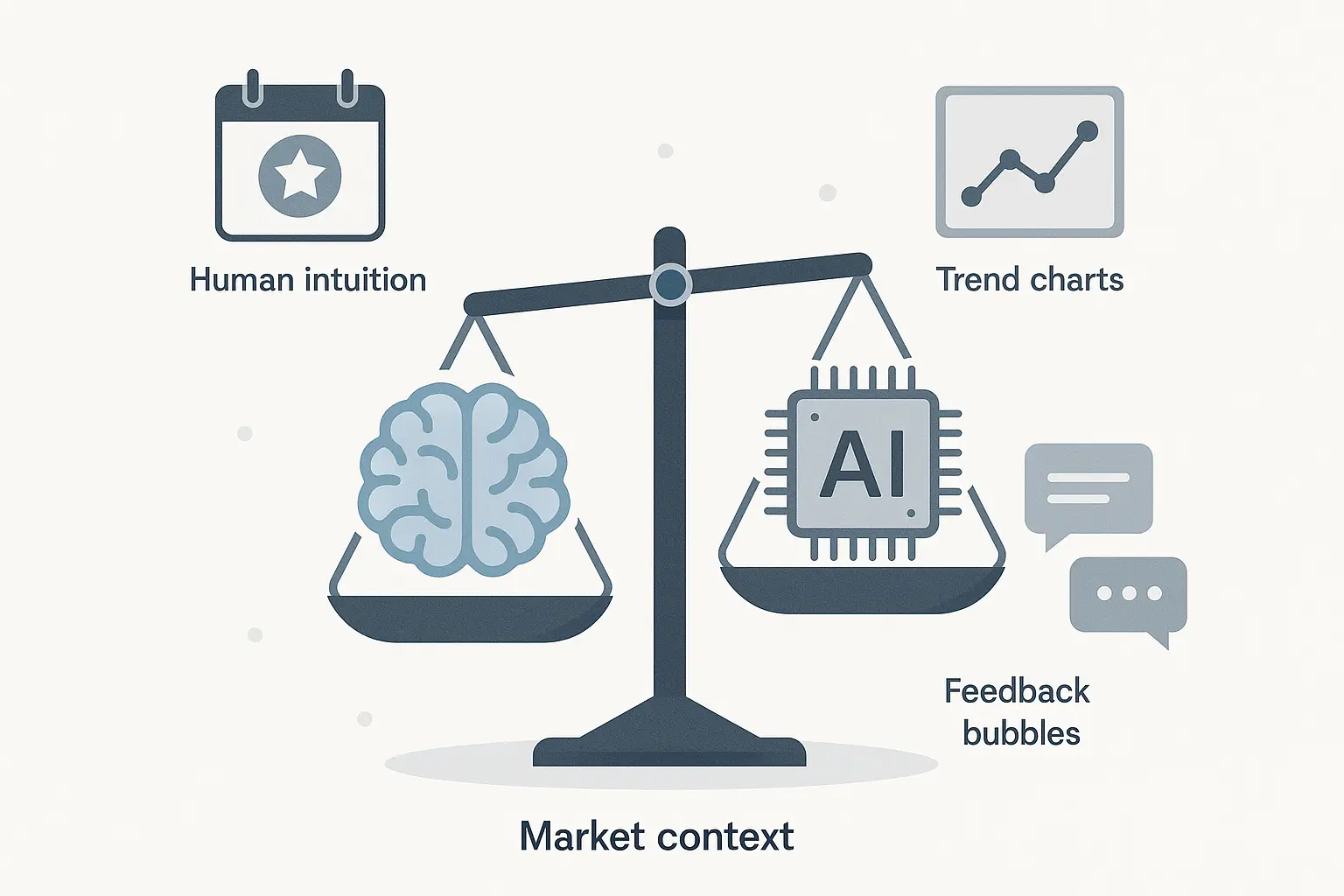You’ve been there. You run a client’s domain through your favorite AI-powered keyword tool, and it spits out a pristine list of high-volume, low-difficulty terms, all neatly organized. The data is clear. The path seems obvious.
But then you look at the list, and… something feels off.
Your gut, honed by years of market experience and countless client conversations, is quietly screaming, “No, that’s not how real customers talk.” The AI suggests targeting “enterprise resource planning software solutions,” but you know their buyers are actually searching for “how to fix my clunky inventory system.”
This is the new frontier for SEO professionals: the standoff between powerful AI recommendations and invaluable human intuition. Who do you trust?
The good news is, you don’t have to choose. This clash isn’t a problem to be solved—it’s an opportunity to uncover a deeper, more powerful strategy.
The Unstoppable Rise of AI in SEO
Let’s be clear: the shift to AI-driven SEO isn’t a trend; it’s a fundamental transformation of our industry. The data is overwhelming. Gartner predicts that by 2026, over 80% of enterprises will have used GenAI in production environments. This isn’t just about efficiency—it’s about performance. A study from MIT Sloan Management Review found that 60% of companies leveraging AI reported an increase in revenue.
In SEO, this translates to tangible benefits. Stanford research showed that AI can boost worker productivity by an average of 14%. For an agency, that means more time for strategy and less time buried in spreadsheets. It’s no surprise that, according to Semrush, 43% of marketers are already using AI for keyword research.
These tools are brilliant at:
- Processing massive datasets: Analyzing thousands of SERPs in seconds.
- Identifying patterns: Spotting statistical trends humans might miss.
- Scaling research: Doing the work of an entire team in minutes.
An AI-powered SEO approach offers the scale and speed modern agencies need to compete. But as powerful as they are, these tools have a blind spot: they lack real-world context.
In Defense of the Gut Feeling: Why Your Intuition Is a Data Point
Your “gut feeling” isn’t magic. It’s a sophisticated form of pattern recognition built over years of experience. It’s your brain’s own proprietary algorithm, running on a unique dataset of past campaigns, client feedback, industry jargon, and cultural nuances.
Here’s what your intuition understands that an AI might miss:
- Semantic Nuance: You know that “cheap wedding photographer” and “affordable wedding photographer” attract two completely different types of clients, even if their search volumes are similar.
- Emerging Trends: You might notice a new phrase popping up on social media or in sales calls long before it registers as a high-volume keyword.
- Buyer Intent: You can feel the difference between a query from a student doing research (“what is CRM”) and a buyer ready to purchase (“best CRM for small sales teams”).
- Brand Voice: You know that a quirky, informal keyword might be perfect for one client but disastrous for a buttoned-up corporate brand.
Ignoring this internal data is like driving with one eye closed. The challenge isn’t to silence your intuition but to learn how to test its hypotheses against the data.
A Framework for Resolving the Conflict
When your gut feeling contradicts the AI, don’t pick a side. Become a detective. Your goal is to understand why there’s a disagreement. Use this four-step framework to find the truth.

Step 1: Formulate Your Hypothesis
Start with your intuition. Articulate exactly what you believe the AI is missing. Don’t just say, “This feels wrong.” Get specific.
Bad Hypothesis: “This keyword list is bad.”
Good Hypothesis: “The AI is recommending keywords based on a national audience, but my client is a local service provider. I believe hyper-local terms with lower volume will convert better.”
Good Hypothesis: “The AI is suggesting technically accurate jargon, but I believe the target audience uses simpler, problem-based language to search.”
Step 2: Validate with “Human” Data Sources
Now, it’s time to find evidence to support your hypothesis. Go where the humans are and listen to how they talk. This is where a holistic omnichannel SEO strategy gives you an edge, since you can pull insights from various platforms.
- Mine the SERPs: Manually Google your intuitive keywords. What kind of content ranks? Are they blog posts, product pages, or forums? Who is ranking—competitors or informational sites? The SERP itself tells a story about intent.
- Explore Online Communities: Check Reddit, Quora, and industry-specific forums. How are real people talking about this topic? What questions are they asking? This is a goldmine for an audience’s natural language.
- Talk to Sales and Support Teams: They are on the front lines, speaking with customers every day. Ask them: “What are the most common questions you get? What exact words do customers use to describe their problems?”
- Review Customer Reviews: Look at your client’s reviews (and their competitors’). The language customers use when they are happy or frustrated is pure, unfiltered voice-of-customer data.
Step 3: Test Both Scenarios
Once you’ve gathered qualitative evidence, it’s time for a quantitative test. You don’t have to commit your entire strategy to one direction. Instead, create small, controlled experiments.
- The AI’s Keyword: Write a blog post or build a landing page optimized for the high-volume, AI-suggested term.
- Your Intuitive Keyword: Create a similar piece of content optimized for the lower-volume, human-language term you believe in.
Track impressions, click-through rates, time on page, and, most importantly, conversions. The goal isn’t just traffic; it’s business results.
Step 4: Refine and Create a Hybrid Model
After a few weeks or months, you’ll have your answer. Sometimes the AI was right, and sometimes your gut was. Most often, the best path is a combination of both.
The ideal outcome is a hybrid model where AI provides the scale, while human expertise offers the strategic direction and refinement. This approach turns a potential conflict into a powerful system of checks and balances.

This synergy—combining machine efficiency with human strategic oversight—is essential. While a PwC report notes that 73% of US companies are using AI, it also highlights that trust remains a major barrier to adoption. By creating a framework that validates AI data with human insight, you build that trust and create a far more resilient strategy.
This is particularly crucial for agencies managing multiple client accounts, where a scalable yet nuanced approach, often achieved through a white-label SEO partnership, is key to delivering consistent results.
Frequently Asked Questions (FAQ)
Q1: Can AI keyword tools ever be completely wrong?
Yes. AI tools are only as good as the data they are trained on. They can be wrong if the data is outdated, if they misinterpret niche jargon, or if they fail to grasp the specific context of a local market or a rapidly changing trend. Think of them as incredibly smart but very literal-minded junior analysts who need senior oversight.
Q2: I’m new to SEO. What if I don’t have a strong “gut feeling” yet?
That’s perfectly normal. Intuition is built from experience. If you’re just starting, lean more heavily on the data, but always complete Step 2 of the framework: validate with human data sources. Spend time reading forums, customer reviews, and analyzing the SERPs manually. This process is how you’ll build the experience that eventually becomes your gut feeling.
Q3: How do I explain this to a client who just wants to see high search volume numbers?
This is a great opportunity to educate your client and demonstrate your strategic value. Frame it as a focus on quality over quantity. Use an analogy: “We could target a keyword that gets 10,000 searches a month from students doing research, or we can target a keyword that gets 500 searches from C-level executives ready to buy. The AI is great at finding the big number. Our job is to find the right audience that will actually grow your business.”
Q4: Should our agency invest in multiple AI tools to cross-reference data?
Cross-referencing is always a good practice. Different tools use different data crawlers and algorithms, so seeing where they agree and disagree can be insightful. However, the most important cross-reference is not another AI but the human data sources mentioned in the framework, like SERPs, forums, and sales teams. Don’t get stuck in “analysis paralysis” by chasing perfect data; focus on creating a feedback loop between data, human insight, and real-world testing.
Your Intuition Is Your Competitive Advantage
In an age where every agency has access to the same powerful AI tools, your team’s experience, market knowledge, and intuition become your ultimate differentiator.
The future of SEO doesn’t belong to the machines or the strategists who resist them. It belongs to those who learn to bridge the gap—using AI for its strengths in scale and data processing, and human expertise for its indispensable grasp of context, nuance, and strategy.
Don’t be afraid to question the data. Your gut feeling isn’t a bug in the system; it’s the most valuable feature you have.


